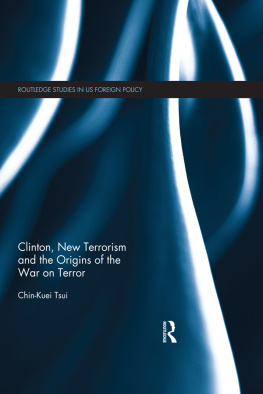William Bush - TO QUELL THE TERROR
Here you can read online William Bush - TO QUELL THE TERROR full text of the book (entire story) in english for free. Download pdf and epub, get meaning, cover and reviews about this ebook. publisher: ICS Publications, genre: Religion. Description of the work, (preface) as well as reviews are available. Best literature library LitArk.com created for fans of good reading and offers a wide selection of genres:
Romance novel
Science fiction
Adventure
Detective
Science
History
Home and family
Prose
Art
Politics
Computer
Non-fiction
Religion
Business
Children
Humor
Choose a favorite category and find really read worthwhile books. Enjoy immersion in the world of imagination, feel the emotions of the characters or learn something new for yourself, make an fascinating discovery.
- Book:TO QUELL THE TERROR
- Author:
- Publisher:ICS Publications
- Genre:
- Rating:5 / 5
- Favourites:Add to favourites
- Your mark:
- 100
- 1
- 2
- 3
- 4
- 5
TO QUELL THE TERROR: summary, description and annotation
We offer to read an annotation, description, summary or preface (depends on what the author of the book "TO QUELL THE TERROR" wrote himself). If you haven't found the necessary information about the book — write in the comments, we will try to find it.
William Bush: author's other books
Who wrote TO QUELL THE TERROR? Find out the surname, the name of the author of the book and a list of all author's works by series.
TO QUELL THE TERROR — read online for free the complete book (whole text) full work
Below is the text of the book, divided by pages. System saving the place of the last page read, allows you to conveniently read the book "TO QUELL THE TERROR" online for free, without having to search again every time where you left off. Put a bookmark, and you can go to the page where you finished reading at any time.
Font size:
Interval:
Bookmark:


Before mounting the scaffold, the Carmelite martyrs
renewed their vows and kissed this tiny terracotta statuette
of the Madonna and Child held by the prioress
(Teresa of St. Augustine).

Washington Province of Discalced Carmelites, Inc., 1999, 2013
ICS Publications
2131 Lincoln Road NE
Washington, DC 20002-1199
800-832-8489
www.icspublications.org
All rights reserved. No part of this book may be reproduced or transmitted in any form or by any means, electronic or mechanical, including photocopying, recording, or by any information, storage or retrieval system without prior written permission from the publisher.
Cover design by Nancy Gurganus of Grey Coat Graphics
Cover photo: Winnie Klotz/Metropolitan Opera from the New York Metropolitan Opera production of Dialogues of the Carmelites
Produced and printed in the United States of America
Library of Congress Cataloging-in-Publication Data
Bush, William, 1929
To quell the terror: the mystery of the vocation of the sixteen Carmelites of
Compigne guillotined July 17, 1794 / William Bush.
p. cm.
Includes bibliographical references and index.
ISBN (paper): 978-0-935216-67-7
ISBN (epub): 978-1-939272-16-4
1. Discalced Carmelite NunsFranceCompigneHistory
18th century. 2. Compigne (France)Church History18th century.
I. Title.
BV4323.F8B87 1999
| 272'.9'094435dc21 | 98-33217 CIP |
For Sylviane Bernanos
 16 November 1998
16 November 1998
Mater Dolorosa, pastel by Mother Teresa of
St. Augustine or Mother Henriette of Jesus. Photo: Hutin

Opening scene from the New York Metropolitan Opera production of
Poulencs Dialogues of the Carmelites. Photo: Winnie Klotz! Metropolitan Opera
I FIRST HEARD OF THE CARMELITES OF COMPIGNE through Georges Bernanoss incomparable last testament, Dialogues of the Carmelites, in 1952. I was a graduate student, twenty-three years of age, completely caught up by Bernanos, foremost Catholic novelist of his time. How could I not be moved by the fact that he, in the last months before his death in 1948 at age sixty, had written those dialogues for a film scenario about sixteen nuns who, like him, were consciously preparing to appear before God?
The masters thesis I was preparing in 1952 led me to Paris four years later as a Fulbright scholar, pursuing a doctoral thesis at the Sorbonne. I had had the unbelievable good fortune of gaining the support of Bernanoss literary executor, the great Swiss critic, Albert Bguin , my mentor even before meeting him. Indeed, Bguins preoccupations with Bernanos were precisely my own: to analyze his texts and manuscripts so as to understand all that that visionary Christian prophet was trying to say.
I was thus in the audience in Paris in 1957 both when Francis Poulencs newly created Dialogues des Carmlites was given at the Opra de Paris and when a theatrical version of Bernanoss text was produced at the Thtre Hbertot. I was far from imagining, however, the rendezvous awaiting me a quarter century later with Bernanoss Carmelites.
When, in 1981, they burst upon my staid life as a university professor, I, several books beyond my Sorbonne thesis, was still working on Bernanos manuscripts. Madame Sylviane Bernanos , widow of Bernanoss second son, Michel, through whom I had first met Bguin, had approached me concerning a new Parisian production of Dialogues of the Carmelites, directed by Raymond Gerome . Sponsored by the office of the Mayor of Paris, Monsieur Jacques Chirac , a fervent admirer of Bernanos, it would aim at total fidelity to Bernanoss text, not allow for any of the usual cuts, and prove the great theatrical event marking the end of the century, Madame Bernanos assured me.
As promised, I delivered to Raymond Gerome by the end of 1982 the authentic text left by Bernanos in his copy books when he took to his deathbed in 1948. As for the alterations Bguin had effected in his edition published in 1949, I dismissed them, knowing he was trying desperately to generate income for Bernanoss destitute widow and six children. The following year, 1983, I learned that our great theatrical event marking the end of the century had foundered because of Bernanos family politics and mounting production costs.
I found this news singularly unmoving, however. I was already caught up by the actual history of the sixteen martyrs of Compigne, just as I had been, more than thirty years before, by Bernanos himself.
I discovered the historical martyrs through my work on Bernanoss manuscripts. The names assigned many of the nuns by Bernanos had in fact been altered by Bguin in preparing his published volume of Dialogues of the Carmelites. Wishing to check the names of the historical martyrs, I dusted off my twenty-five-year-year-old copy of Father Bruno de Jsus Maries authoritative compendium, Le Sang du Carmel, fruit of twenty years of research on the Compigne martyrs by Frances foremost twentieth-century Carmelite scholar.
History, I found, had nothing to do with the differences in names I had discovered, and true historical parallels existed for four characters only: the two prioresses (Madame de Croissy and Madame Lidoine); the young novice, Sister Constance ; and Sister Marie de lIncarnation. The actions and dialogues of these four characters, however, were largely fictional.
Dialogues of the Carmelites is centered on an imaginary heroine, Blanche de la Force, created by Gertrud von Le Fort as protagonist for her novella Die Letzte am Schafott [The Last One at the Scaffold], translated into English as Song at the Scaffold. On that novella was based the film scenario for which Bernanos had supplied his dialogues. The actual historical martyrdom was therefore a mere backdrop for Blanches fictional story. I thus found it imperative to fix my mind firmly on the facts of the actual martyrdom if I were to avoid schizophrenia and deprivation in being denied von Le Forts too-beautiful heroine.
Thinking of Poulencs many admirers in English-speaking countries, I suddenly wanted very much to correct, through a modest little volume in English, all the misinformation sown by all the derivatives of Gertrud von Le Forts novella. For the French material I thought Father Brunos compendium should suffice, though I did resolve to go consult the English sources at Stanbrook Abbey in England, known to Father Bruno only through copies. Seventeen sisters from that contemplative Benedictine community had been imprisoned in Compigne with the martyrs in 1794 and a written account of the Carmelites imprisonment and departure for execution in Paris had been piously preserved. In many ways Stanbrook might even be called a major guardian of their cult, for it had served as headquarters for their beatification by Rome in 1906.
Font size:
Interval:
Bookmark:
Similar books «TO QUELL THE TERROR»
Look at similar books to TO QUELL THE TERROR. We have selected literature similar in name and meaning in the hope of providing readers with more options to find new, interesting, not yet read works.
Discussion, reviews of the book TO QUELL THE TERROR and just readers' own opinions. Leave your comments, write what you think about the work, its meaning or the main characters. Specify what exactly you liked and what you didn't like, and why you think so.













